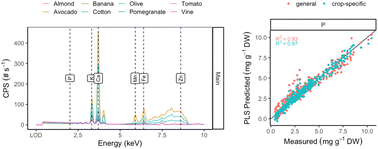Measuring foliar mineral concentrations by X-ray fluorescence requires crop-specific partial regression models
Abstract
Precision fertilization is crucial for sustainable and efficient world farming. However, traditional chemical mineral analyses are costly and time-consuming, which limits the amount of data that can be collected and the frequency of updates to fertilization programs. Hence, we set to restructure mineral diagnostics in agriculture. First, we developed a unique experimental setup and produced ∼2000 leaf samples at a wide concentration range of macronutrients (0.5–10 mg P per g, 1–50 mg K per g, or 2–40 mg Ca per g) and trace elements (0.05–0.4 mg Mn per g, 0.05–0.4 mg Fe per g, or 0.005–0.06 mg Zn per g) in multiple crops. We scanned the foliar samples by X-ray fluorescence and determined that emissions at the 1–10 keV range resonate with macronutrients and trace elements in plants. While initial correlations for trace elements were unsatisfactory for trace elements (R2 < 0.7), we applied a range of statistical tools to support chemical spectroscopy for the mineral matrices in leaves. The chemometric investigation developed into crop-specific predictive models that fitted chemical analyses of mineral concentrations by R2s of ∼0.9 and an RMSE of 5% of the concentration range. We also developed a single model for all the crops but concluded that it often critically reduced the accuracy (a fourfold increase in RMSE) of the mineral analyses. Nonetheless, the XRF-PLSR approach is rapid and significantly more cost effective than traditional laboratory essays. Thus, developing models for numerous crops is feasible, and XRF tools could integrate mineral analyses in decision support tools for farming.



 Please wait while we load your content...
Please wait while we load your content...